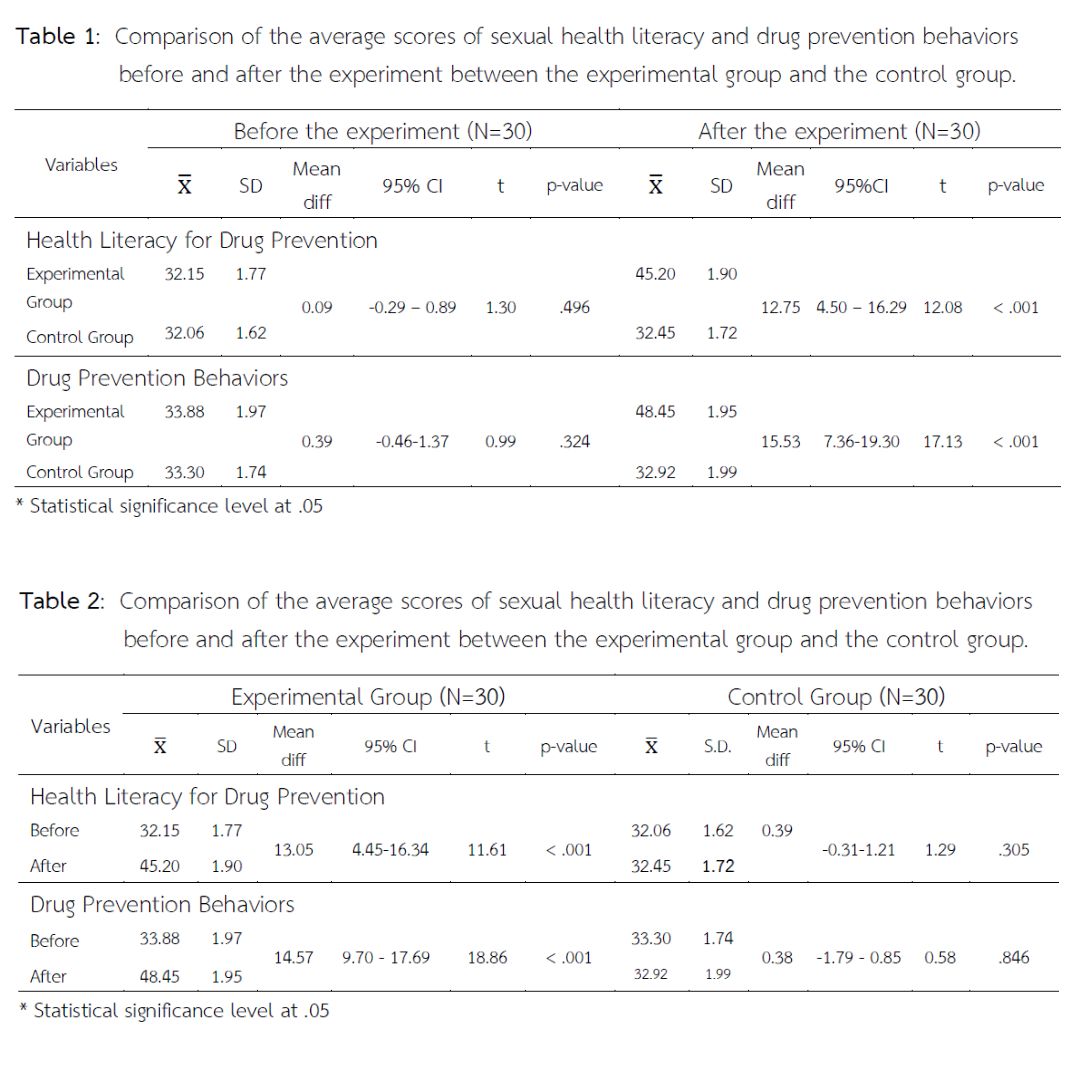ผลของโปรแกรมความรอบรู้ด้านสุขภาพร่วมกับ “คู่เสี่ยวสานพลัง” เพื่อส่งเสริมพฤติกรรมการป้องกันยาเสพติด โรงเรียนโนนโพธิ์ศรีวิทยาคม อำเภอซำสูง จังหวัดขอนแก่น
คำสำคัญ:
ความรอบรู้ด้านสุขภาพ, คู่เสี่ยวสานพลัง, พฤติกรรมการป้องกันยาเสพติดบทคัดย่อ
ปัญหาการเสพยาเสพติดในกลุ่มเด็กและเยาวชนนับเป็นปัญหาที่สำคัญของประเทศ โดยเฉพาะกลุ่มนักเรียนซึ่งกำลังเติบโตไปเป็นกำลังสำคัญในการพัฒนาของประเทศชาติ การวิจัยกึ่งทดลองนี้ มีวัตถุประสงค์เพื่อศึกษาผลของโปรแกรมความรอบรู้ด้านสุขภาพร่วมกับ “คู่เสี่ยวสานพลัง” เพื่อส่งเสริมพฤติกรรมการป้องกันยาเสพติด โรงเรียนโนนโพธิ์ศรีวิทยาคม อำเภอซำสูง จังหวัดขอนแก่น กลุ่มตัวอย่างการวิจัยมี 2 กลุ่ม ได้แก่ กลุ่มทดลอง คือ นักเรียนระดับชั้นมัธยมศึกษาโรงเรียนโนนโพธิ์ศรีวิทยาคม จำนวน 30 คน ได้รับโปรแกรมความรอบรู้ด้านสุขภาพร่วมกับ “คู่เสี่ยวสานพลัง” ที่ผู้วิจัยสร้างขึ้น และกลุ่มเปรียบเทียบ คือ นักเรียนระดับชั้นมัธยมศึกษาที่โรงเรียนเปรมติณสูลานนท์ จำนวน 30 คน เข้าร่วมกิจกรรมของโรงเรียนตามปกติ ระยะดำเนินกิจกรรม 10 สัปดาห์ เก็บรวบรวมข้อมูลก่อนและหลังการทดลองด้วยแบบสอบถาม วิเคราะห์ข้อมูลโดยใช้สถิติเชิงพรรณนา ได้แก่ ค่าความถี่ ร้อยละ ค่าเฉลี่ย และค่าส่วนเบี่ยงเบนมาตรฐาน และเปรียบเทียบค่าเฉลี่ยคะแนนของกลุ่มทดลองและกลุ่มเปรียบเทียบก่อนและหลังการทดลอง ด้วยสถิติ Paired t–test และ Independent t–test กำหนดระดับนัยสำคัญที่ระดับ .05 ผลการศึกษาพบว่า ภายหลังการทดลอง กลุ่มทดลองมีค่าเฉลี่ยคะแนนความรอบรู้ด้านสุขภาพในการป้องกันยาเสพติดมากกว่ากลุ่มเปรียบเทียบ 12.75 คะแนน อย่างมีนัยสำคัญทางสถิติ (95% CI = 4.50 – 16.29 ; p-value < .001) และค่าเฉลี่ยคะแนนพฤติกรรมการป้องกันยาเสพติดมากกว่ากลุ่มเปรียบเทียบ 15.53 คะแนน อย่างมีนัยสำคัญทางสถิติ (95% CI = 7.36 - 9.30; p-value < .001) ดังนั้น การพัฒนาพฤติกรรมการป้องกันยาเสพติดและลดปัญหายาเสพติดในโรงเรียน สามารถใช้แนวทางตามโปรแกรมความรอบรู้ด้านสุขภาพร่วมกับ “คู่เสี่ยวสานพลัง” ได้
เอกสารอ้างอิง
Chomsri P. et al. (2023). The Association Between Subsatnce literacy with self-control in the ethnic elementary students. Journal of Social Science and Cultural, 7(5), 242-255.
Health Promotion Foundation. (2023). 4 Main Factors Leading to Adolescent Drug Use. https://www.thaihealth.or.th/category/infographic
House, J. S. (1981). The Association of Social Relationship and activities with mortality: Community health study. American Journal Epidemiology, 3(7), 25-30.
Janthamungkun J. et al. (2020). The effectiveness of life skills enhancement program with participatory learning to prevent substance abuse among senior primary school students in Chaiyaphum province. Journal of Mental Health of Thailand, 28(4), 304-316.
Jirawatkul, A. (2009). Statistics for Health Sciences Research. Bangkok: Vithayapat.
Office of the Secretary, Committee on Treatment and Rehabilitation of Drug Addicts, Ministry of Public Health. (2023). Data from the Reporting System for Monitoring and Surveillance of Drug Problems. https://antidrugnew.moph.go.th/Runtime/Runtime/Form/FrmPublicReport/
Office of the Secretary, Committee on Treatment and Rehabilitation of Drug Addicts, Ministry of Public Health. (2023). Data from the Reporting System for Monitoring and Surveillance of Drug Problems. https://antidrugnew.moph.go.th/Runtime/Runtime/Form/FrmPublicReport/
Phalanisong, M. (2021). Factors Related to Drug Prevention Behaviors of Vocational Certificate Students in Vocational Education Institutions, Kamphaeng Phet Province (Research Report). Kamphaeng Phet Provincial Public Health Office, Ministry of Public Health.
Pimjan S. et al. (2024). The Effectiveness of Health Literacy Program for New Risk Student Group to Preventive Alcohol Drinking Behaviors in Opportunity Expansion School Pak Thong Chai District Nakhon Ratchasima Province. Primary Health Care Journal (Northeastern Edition), 39(1), 12-23.
Ranee S. et al. (2022). Effect of a Smoking and Substance Abuse Prevention Program by Using Islamic Principles on Health Literacy on Smoking and Substance Abuse Prevention among Muslim Youth in Private Religious Schools in Three Southern Border Provinces. Journal of Behavioral Science for Development, 14(1), 134-152.
Sorensen K. et al. (2012). Health literacy and public health: a systematic review and integration of definitions and models. BMC Public Health, 12, 80
Sorensen K. et al. (2013). Measuring health literacy in populations: illuminating the design and development process of the European Health Literacy Survey Questionnaire (HLS-EU-Q). BMC Public Health, 13, 948.
Sunchai, K. (2011). Relationship between Psychosocial Variables and Academic Achievement among Professional Certificate Students. Research Methodology & Cognitive Science, 8(2), 72-85.
United Nations Office on Drugs and Crime. (2023). World Drug Report 2023. https://www.unodc.org/res/WDR2023/WDR23_Exsum_fin_DP.pdf

ดาวน์โหลด
เผยแพร่แล้ว
วิธีการอ้างอิง
ฉบับ
บท
การอนุญาต
ลิขสิทธิ์ (c) 2024 วารสารสาธารณสุขมูลฐาน (ภาคตะวันออกเฉียงเหนือ)

This work is licensed under a Creative Commons Attribution-NonCommercial-NoDerivatives 4.0 International License.



